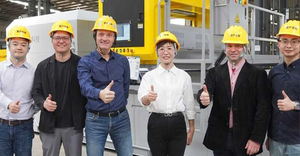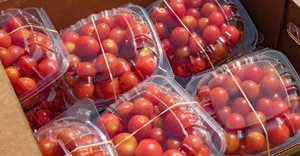Connecticut town maximizes waste diversion at local festival.
January 1, 2009
Virginia Walton, Recycling Coordinator, Mansfield, Conn.
Festival on the Green is a community event in Mansfield, Conn., that celebrates small-town life. Mansfield officials work hard to be on the leading edge of waste reduction and recycling. To that end, resident trash cans are diminutive compared to the containers provided for compost and bottle and can recycling. Each is topped with a sign clearly designating which items should be deposited in the bin.
The population of Mansfield, home to the University of Connecticut (UConn), fluctuates between 15,000 and 25,000, depending on whether school is in session. With UConn as the town's primary employer, there is no business district. The Mansfield Downtown Partnership is sponsoring a project to establish a traditional New England town center, comprised of living quarters and shops clustered along narrow streets and a village green. The Festival on the Green was established to showcase this vision. From the beginning, the festival committee wanted the celebration to be a low-waste event, in keeping with the sustainable design guidelines for the town center.
Mansfield's festival is patterned after similar low-waste fairs. Both the Common Ground Fair in Maine and the Lowell Folk Festival in Massachusetts compost and recycle 90 percent of the waste produced during their multi-day events. The festival committee decided that if these much larger events can do it over the course of several days, it was certainly manageable for a five-hour event.
It has been a learning process since the festival's inception in 2004, spawning a range of improvements. Below is a summary of waste diversion efforts at the festival:
2004 Results: 55 percent diverted
Borrowed UConn's 55-gallon barrels, which were heavy to move and cumbersome to install.
Purchased ClearStream recycling containers (clear bag and laundry-hamper-style frame) for recycling cans and bottles.
Supplied food vendors with compostable forks and spoons.
Volunteers posted by each waste station (10 waste stations, 28 volunteers).
2005 Results: 72 percent diverted
Purchased ClearStream containers for trash, which were much easier to install and remove.
Used small cans for composting.
Reduced the number of waste stations to six.
2006 Results: 85 percent diverted
Posted informational signs at each waste station.
Added compostable plates, bowls and cups to food vendor supplies
Used ClearStream container for compost and small cans for trash.
2007 Results: 72 percent diverted
Removed volunteers from waste stations.
2008 Results: 87 percent diverted
Made larger signs (18" × 24").
Had environmental organizations adopt a waste station for the day.
Worked with vendors for source reduction of waste at their booths.
What Worked
Larger signs
After introducing signs listing the products that go in each container, organizers tried eliminating volunteers stationed at each waste area. But fairgoers, distracted by the festivities, took little notice of the signs and pitched their trash in the closest open container. For the 2008 festival, the signs were enlarged to 18" × 24", leading more people to stop and read them.
Adopting a waste station
Organizers learned that it was necessary to have volunteers with a vested environmental interest manning the waste stations. Local environmental groups were asked to "adopt" each of the six waste stations, staffing them for the duration of the event. Because these volunteers valued the low-waste effort, they were not bashful about helping fairgoers properly dispose of their waste.
Small trash cans
By using the large containers for the compostable and recyclable waste and a small cans for everything else, we matched the container sizes with our intentions.
Vendor cooperation
All correspondence with vendors emphasized the committee's low-waste goal. That message was reiterated through direct conversations with all participants, in which vendors indicated what they planned to sell and organizers were able to give practical guidance on low-waste alternatives.
Food service supplies
Each year, the festival committee seeks sponsorships. Through donations from Willimantic Waste Paper, the region's materials recovery facility, the committee has been able to provide food vendors with compostable cups, plates, bowls and cutlery. This saves the vendors money, and makes the waste stream predictable, so waste station signs can include specific examples.
Year of Festival | Total Pounds of Waste | Total Pounds: Bottles & Cans Recycled | Total Pounds: Composted | Percent of Waste Recycled & Composted |
|---|---|---|---|---|
2004 | 182 | 29 | 71 | 55% |
2005 | 123 | 28 | 60 | 72% |
2006 | 237 | 40 | 108 | 85% |
2007 | 270 | 89 | 104 | 72% |
2008 | 257 | 56 | 166.5 | 87% |
Virginia Walton
Recycling Coordinator
Mansfield, Conn.
You May Also Like


